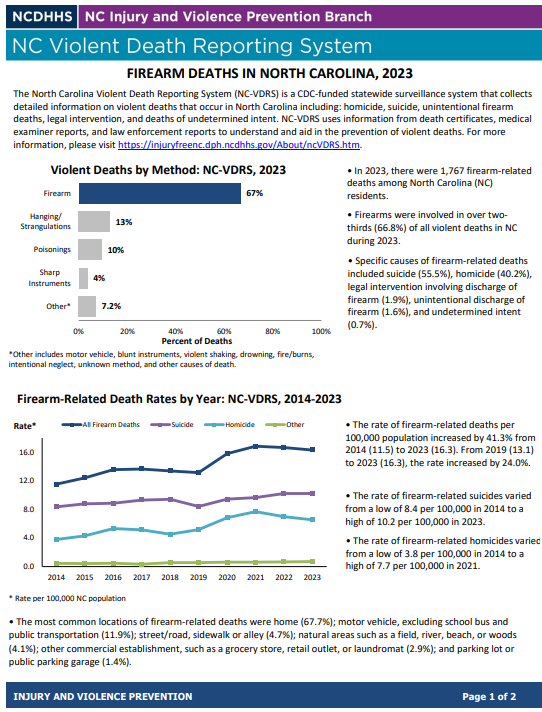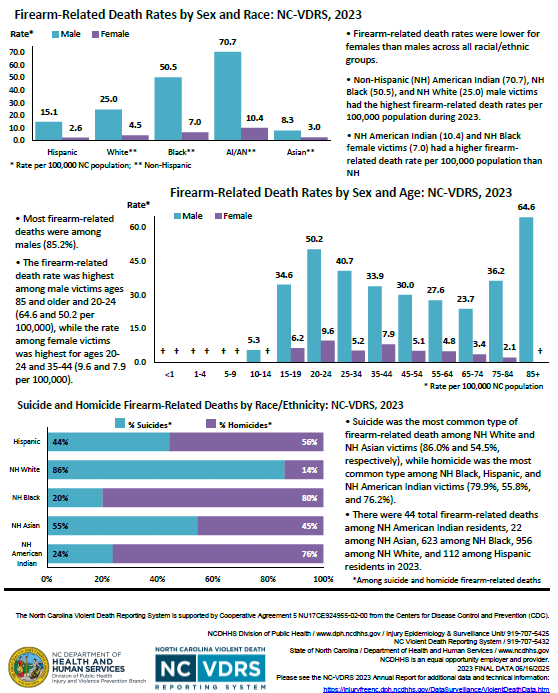Injury and Violence Prevention Branch
Firearm Safety Awareness and Education
 This page is dedicated to providing data on firearm-related injuries and death in North
Carolina, information about firearm safe storage and how this protects children and youth from
firearm-related deaths and injuries, and resources and tools that individuals and communities
can use.
This page is dedicated to providing data on firearm-related injuries and death in North
Carolina, information about firearm safe storage and how this protects children and youth from
firearm-related deaths and injuries, and resources and tools that individuals and communities
can use.
After viewing this page, if you find yourself needing more information on firearm-related
injuries, please review the Injury and Violence Prevention Branch
data
request policies and procedures
for steps on how to make a custom data request.
Public Health Approaches to Reduce Violence and Firearm Injury
 Keeping Families and Communities Safe:
Public Health Approaches to Reduce Violence and Firearm Misuse Leading to Injury and Death
Keeping Families and Communities Safe:
Public Health Approaches to Reduce Violence and Firearm Misuse Leading to Injury and Death
This report addresses public health strategies to increase community and family safety from firearm violence and misuse in a new plan focused on implementing public health actions to reduce firearm injury and death.
[+] Expand All Items Below | [-] Collapse All Items Below
Recommendations on Firearm Safety for Suicide Prevention
The Importance of Firearm Safe Storage
Safe storage of firearms reduces unintentional death, injury, and hospitalization. Additionally, when firearms are stored safely, they are less available as a means of suicide or intentional harm to others. This is especially true for children and youth.
Reduce Death, Injury, Hospitalization to Children and Youth
Children are naturally curious and seek to learn about their environment through touch and play. Unfortunately, when a child or children find an unlocked and loaded firearm, they can unintentionally hurt themselves or someone else nearby. Keeping firearms unloaded and locked away using a cable lock or placing them in lock boxes or gun safes can prevent injuries and death resulting from curiosity and play.
Reduce Suicide
"Many suicide attempts are hastily decided-upon and involve little or no planning. The particular means chosen for a suicide attempt may determine whether one who attempts suicide lives or dies. Access to firearms is a risk factor for suicide. 90% of those who attempt suicide and survive do not go on to die by suicide later. Firearms used in youth suicide usually belong to a parent. Reducing access to lethal means saves lives. (Means Matter)" 1
Nine out of 10 suicide attempts using a firearm are lethal.2
Reduce Violence
Safe firearm storage can also prevent children and youth from accessing firearms and using them to injure or kill others.
NC Safe Storage Law
The North Carolina law that concerns safe storage of firearms is §14-315.1. This law is referred to as the NC Safe Storage Law and states:
§ 14-315.1. Storage of firearms to protect minors.
(a) Any person who resides in the same premises as a minor, owns or possesses a firearm, and stores or leaves the firearm (i) in a condition that the firearm can be discharged and (ii) in a manner that the person knew or should have known that an unsupervised minor would be able to gain access to the firearm, is guilty of a Class 1 misdemeanor if a minor gains access to the firearm without the lawful permission of the minor's parents or a person having charge of the minor and the minor:
(1) Possesses it in violation of G.S. 14-269.2(b);
(2) Exhibits it in a public place in a careless, angry, or threatening manner;
(3) Causes personal injury or death with it not in self defense; or
(4) Uses it in the commission of a crime.
(b) Nothing in this section shall prohibit a person from carrying a firearm on his or her body, or placed in such close proximity that it can be used as easily and quickly as if carried on the body.
(c) This section shall not apply if the minor obtained the firearm as a result of an unlawful entry by any person.
(d) "Minor" as used in this section means a person under 18 years of age who is not emancipated. (1993, c. 558, s. 2; 1994, Ex. Sess., c. 14, s. 11.)
What does the law mean?
Gun owners who live with a person under the age of 18 (a minor) must make sure that the minor does not gain access to the firearm. This law speaks to the need to safely store firearms to avoid injury and death.
Data on Firearm-Related Deaths and Injuries
NC-FASTER: Firearm Injury Surveillance Through Emergency Rooms
Launched in 2020, the CDC’s Firearm Injury Surveillance Through Emergency Rooms (FASTER) program has provided funding to 10 states, including North Carolina. NC-FASTER is a collaboration between the NC Division of Public Health Injury and Violence Prevention Branch and UNC-Chapel Hill’s Injury Prevention Research Center and the Carolina Center for Health Informatics in the Department of Emergency Medicine. It provides surveillance data in near-real time on emergency department visits for nonfatal firearm injuries.
NC-FASTER helps address important gaps in timely data availability for nonfatal firearm injuries. Timely reporting at state- and local-levels through FASTER allows states and communities to detect surges in violence, understand trends in firearm injuries by certain demographic characteristics, and facilitate rapid and focused public health prevention and response.
NC-FASTER releases quarterly fact sheets with provisional data on nonfatal firearm injury related Emergency Department visits to inform the work of prevention and response partners across the state, which are available on the NC DETECT website.
NC-FASTER Quarterly Data Updates
These reports provide updates on emergency department visit trends for nonfatal firearm injuries in NC. Updates will be posted quarterly.
More detailed information on NC-FASTER activities is available in the NC-FASTER Annual Data Reports.
Overall Data on Firearm-Related Deaths and Injuries in North Carolina
Data on Firearm-Related Deaths and Injuries
-
Core Child Firearm Slides, 2023
Added 10/02/2025
Data slides that provide an overview of the burden of firearm injury deaths, hospitalizations, and emergency department visits among North Carolina children ages 0-17 -
Core Firearm
Injury Slides, 2023
Updated 08/19/2025
Data slides that provide an overview of firearm injury deaths, hospitalizations, and emergency department visits among North Carolina residents. -
Firearm
Injury and Death in North Carolina, 2023
Added 08/21/2025
This fact sheet outlines the burden of firearm injury and death among North Carolina residents.
County-Level Firearm Data Tables
See the dashboard below for firearm injury and death data.
This table includes the most recent finalized data from 2017 to present on firearm injuries and deaths among NC residents. If additional years of data are needed, please submit a data request .
To navigate the dashboard, use the filter boxes next to the table.
-
The Source box allows you to switch between death certificate
data,
hospitalization data, Emergency Department (ED) visit data coded for firearm
injury,
and NC FASTER ED visit syndromic data.
- ED visit data include injury ED visits with an ICD-10-CM diagnosis code for firearm injury.
- NC-FASTER syndromic surveillance data include injury ED visits with an ICD-10-CM diagnosis code for firearm injury, or mention of a firearm injury as a chief complaint of the visit. Firearm injuries are flagged using free text search for key terms in the chief complaint input by the provider, for example “GSW” OR “Gunshot” OR “gun shot.” For more information on NC DETECT or the full NC-FASTER syndromic surveillance definition, visit https://ncdetect.org/.
- The Data Type box allows you to display either counts by county and year, or rates per 100,000 by county and year.
-
The Intent box allows you to filter the data by firearm injury
intent: Assault, Unintentional, Legal Intervention, Self-Inflicted,
Undetermined, or
Unknown (for ED Syndromic data only).
Note: Intent coding in the ED visit data is inaccurate and in need of improvement for firearm injury tracking. There is an overcount of unintentional firearm injuries and an undercount of undetermined and intentional injuries, such as assault and self-harm . ICD-10-CM diagnosis codes for “Undetermined” intent are assigned as “Unknown”.
- Use the check-box menu below County if you wish to only view a single county, or a specific selection of counties. Uncheck “All” and then select your counties of choice.
State Firearm Injury ORION Reports
These ORION reports provide statewide data from 2019-2023 on firearm injury deaths, hospitalizations, and ED visits by sex, age, and race/ethnicity. Reports are available by injury intent, including unintentional, self-inflicted, and assault, as well as firearm injuries of all intents.
- Firearm Injuries, All Intents
- Firearm Injuries, Assault
- Firearm Injuries, Self-Inflicted
- Firearm Injuries, Unintentional
County Firearm Injury ORION Reports
These ORION reports include county-level data from 2019-2023 on firearm injury deaths, hospitalizations, and ED visits by sex, age, and race/ethnicity.
Firearm-Related Deaths
2023 Firearm Deaths in North Carolina
Special Emphasis Reports: Firearm Injuries
The Firearm Injury Special Emphasis Report provides a factual overview of the impact and magnitude of firearm injury by age, gender, and race/ethnicity in North Carolina. This report also includes information on firearm injury prevention strategies and activities occurring in our state.
- Added 10/25/22: 2020 Firearm Injury Special Emphasis Report
Data on Safe Storage of Firearms in North Carolina
U.S. Firearm Safe Storage Data
For More Information
How to Obtain a Free or Discounted Gun Lock
A Toolkit for Communities to Use for Firearm Safety Education and Awareness
The following is a guide and supporting materials to help you create a gun safety team in your community, a crucial first step to local firearm safety education and awareness. Thank you to the Durham County Gun Safety Team for making these excellent resources available to the public.
- Creating a Gun Safety Team Implementation Guide (PDF, 5.5 MB)
- Creating a Gun Safety Team PowerPoint Presentation (PDF, 216 KB)
Additional Resources
There are many issues related to firearm safety; here are some categories and resources to help.
NC Child Fatality Task Force, Firearm Safety Stakeholders' Group
In 2017, a diverse group of stakeholders interested in keeping children and youth safe met to discuss ways to promote safe storage of firearms.
- Report and Recommendations
- Firearm Safety Fact Sheet
- Data from the NC Violent Death Reporting System (NC VDRS)
Hunter Education
- Hunting Checklist for Families
- The Hunter Education Program of the N.C. Wildlife Resources Commission provides free hunter education courses throughout the year in every county.
Suicide Prevention
- If you or someone you know is thinking about suicide, contact the National Suicide Prevention Lifeline at: 1-800-273-TALK (1-800-273-8255)
- Suicide Prevention Resource Center
- Suicide Prevention: A Role for Firearm Dealers and Range Owners (New Hampshire Gun Shop Project)
Domestic Violence
Other Resources
- North Carolinians Against Gun Violence (NCGV) is a nonprofit dedicated to reducing gun death and injury.
- Project ChildSafe is a program to promote firearms safety and education and a source of free cable-style gun locks.
- Means Matter is a campaign to increase the proportion of suicide prevention groups who promote activities that reduce a suicidal person’s access to lethal means of suicide.
- Association of Increased Safe Household Firearm Storage with Firearm Suicide and Unintentional Death Among US Youths
- Limiting Access to Firearms as a Suicide Prevention Strategy Among Adults
- Home Gun Safety Queries in Well-Child Visits
- What is Safe Household Firearm Storage to Prevent Deaths Among US Youths?
References
- 1 Means Matter website from the Harvard T.H. Chan School of Public Health. Retrieved from http://www.hsph.harvard.edu/means-matter/.
- 2 Means Matter website from the Harvard T.H. Chan School of Public Health. Retrieved from http://www.hsph.harvard.edu/means-matter/.
- 3 Hobbs, Tawnell D. (April 5, 2018). "Most Guns Used in School Shootings Come from Home," Wall Street Journal.
Last Modified: 10-02-2025




